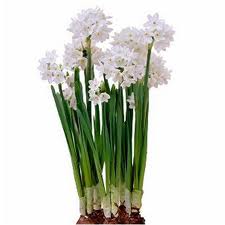 I was at the Philadelphia Flower Show during one of the many snow storms that hit the northeast this year and I was struck by the number of flowers in bloom. There were thousands and thousands of perfect flowers decorating every aspect of the event. These flowers had been forced to grow out of season to allow them to go to the show.
I was at the Philadelphia Flower Show during one of the many snow storms that hit the northeast this year and I was struck by the number of flowers in bloom. There were thousands and thousands of perfect flowers decorating every aspect of the event. These flowers had been forced to grow out of season to allow them to go to the show.
You can force flowers and fruit in your own greenhouse if you want to enjoy flowers during the winter months when nothing very much is blooming outside. Your first job is to decide what plants you want to force. Bulbs such as tulips, daffodils and other narcissi are favorites. In fact, you may already have forced some paperwhites for Christmas. You can also force fruit such as strawberries, rhubarb, peas, beans, and even early tomatoes.
When you buy paperwhite narcissus they have been ‘pre-chilled’ – that is, they have been put in a refrigerator for six to eight weeks before you buy them. When you take them home, you plant them no matter what time of year it is, put them in a warm location and in six to eight weeks the powerful aroma of these bulbs along with their yellow and white flowers permeates the room.
For you to force any bulb, all you need do is put that bulb in a cold place for between six and eight weeks, the chiller box of a refrigerator is ideal. Some bulbs can take freezing temperatures but many cannot. A general rule that if your plant will survive outside during frost, it will survive the icebox. If it will not survive a frost, cool it in the refrigerator only. Leave the bulbs or plants in the refrigerator for at least six weeks to fool the plant into thinking that it has gone through a cold winter.
At the end of that time take it out and plant it up. Put the container in a warm location where it will get sixty to seventy degree temperatures and full sun. A south facing window is ideal, but you should move the container back from the window at night or cover it to protect it from cold air.
Water and lightly fertilize (about 1/4 of your normal fertilizer each week) until you see the first shoots, then increase the amount of fertilizer as the plants come into bloom. Sit back and enjoy the show.


